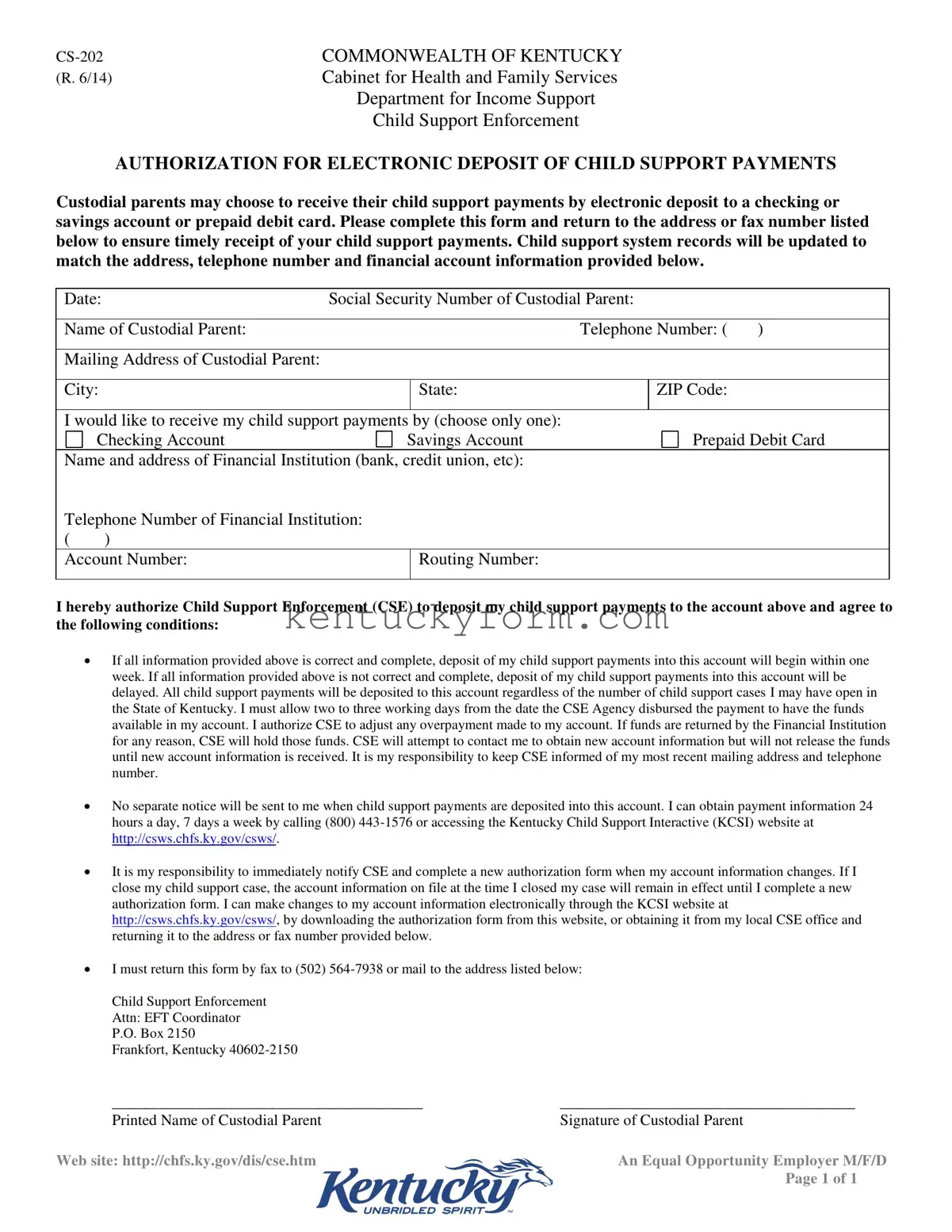The Kentucky CS-202 form is similar to the Direct Deposit Authorization form used by employers for payroll purposes. Both types of forms collect financial institution details, including account and routing numbers, from the recipient to set up electronic deposits. The direct deposit format ensures wages or payments, like child support in the case of the CS-202, are transferred directly into the designated bank account. This process eliminates the need for physical checks and aims to expedite the availability of funds.
Another document similar to the CS-202 form is the Social Security Direct Deposit form. This form allows beneficiaries of Social Security benefits to receive their payments electronically, paralleling the CS-202 form's purpose for child support payments. By providing personal and bank account information, recipients can ensure a secure and swift receipt of funds, reducing the reliance on postal services and enhancing convenience.
The Tax Refund Direct Deposit form, used when filing tax returns, also shares similarities with the Kentucky CS-202 form. Tax filers provide their bank account information to have their refunds deposited directly into their accounts. This parallels the electronic deposit feature of the CS-202, which aims to make payments faster and more secure compared to traditional check-based refunds or support payments.
The Unemployment Benefits Direct Deposit Authorization is another relevant form. Individuals receiving unemployment benefits can opt for their payments to be directly deposited into their bank accounts. Similar to the CS-202 form, it requires the recipient’s bank account details to set up the electronic transfer, thereby simplifying the process of receiving payments and ensuring quicker access to funds compared to check-based methods.
A Pension Plan Distribution Direct Deposit form is akin to the Kentucky CS-202 in its objective to streamline payments. Retirees or beneficiaries specify their bank account information for electronically receiving pension distributions. This form and the CS-202 share the goal of utilizing direct deposit to eliminate delays and the need for paper checks, providing a secure and efficient way to manage financial transactions.
The Housing Assistance Payment (HAP) Direct Deposit form, utilized within housing assistance programs, also mirrors the CS-202 form's functionality. By collecting bank account details from landlords or property managers, the HAP form facilitates the electronic transfer of funds, similar to how child support payments are deposited for custodial parents. This system improves the reliability and speed of payment delivery, benefitting both providers and recipients.
The Veterans Affairs (VA) Benefits Direct Deposit Enrollment form is designed for veterans to receive their benefits via electronic transfer. Like the CS-202 form, veterans provide personal and banking information to set up direct deposits. This method ensures timely and secure access to benefits, reflecting the shared advantages of electronic processing between different types of assistance and support payments.
The College Financial Aid Disbursement Direct Deposit form, which allows students to receive financial aid refunds directly to their bank accounts, shares objectives with the CS-202 form. By facilitating electronic deposits, both forms aim to enhance the speed and security of fund transfers. This similarity showcases the broad application of direct deposit technologies across various types of payments, from child support to educational assistance.
The Public Assistance Benefits Direct Deposit Enrollment form enables individuals receiving government assistance, such as welfare or food stamps, to have their benefits deposited into their bank accounts, akin to the Kentucky CS-202 form. This direct deposit functionality eliminates the wait and security concerns associated with receiving physical checks, underscoring the universal benefits of opting for electronic transfers in public and private financial transactions.

